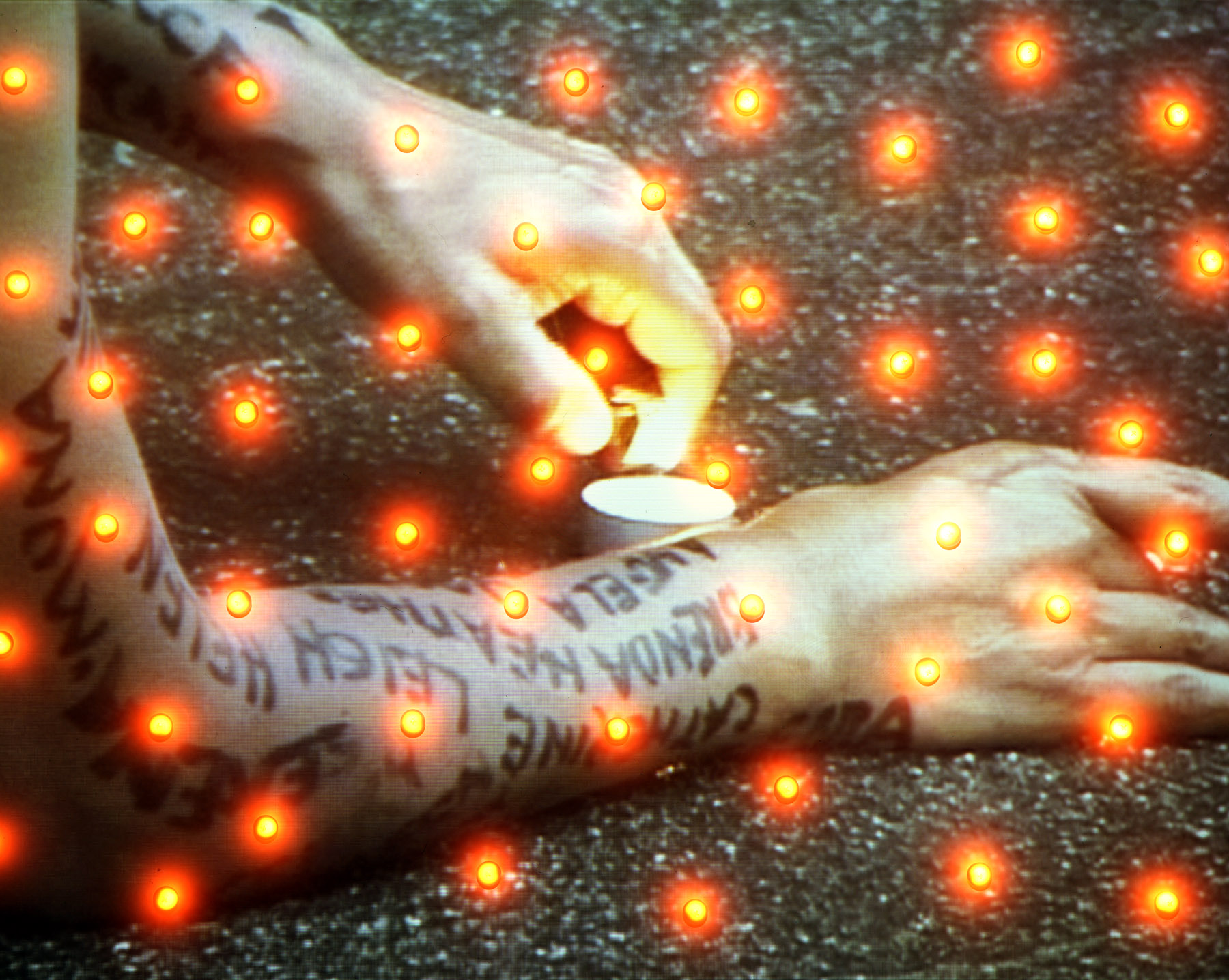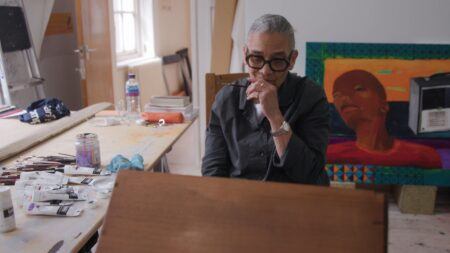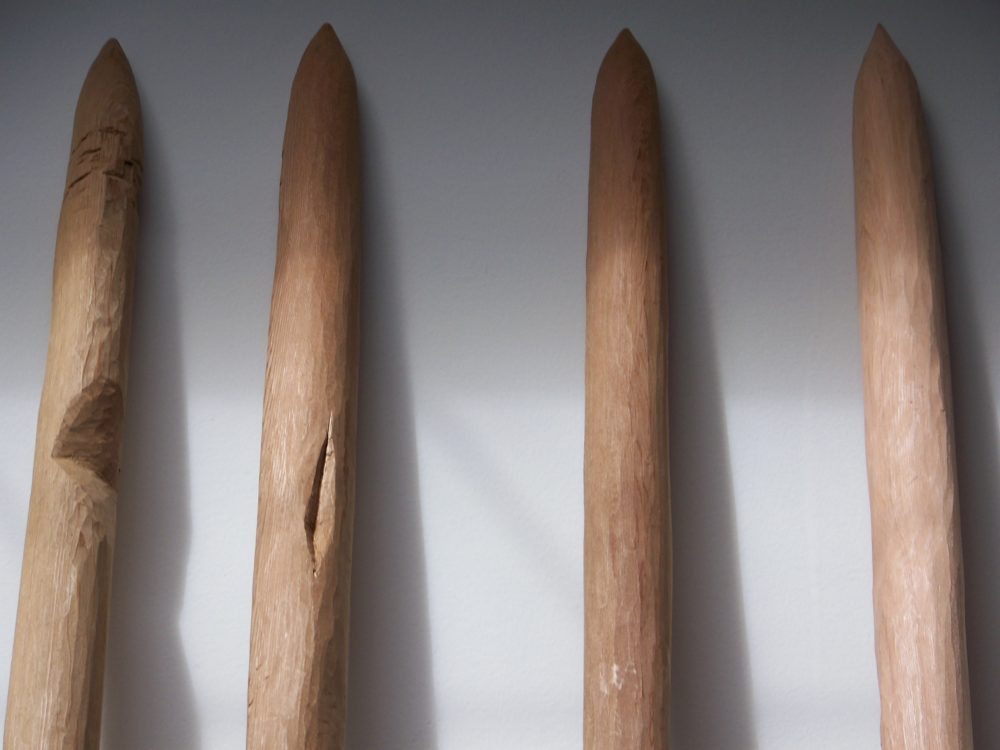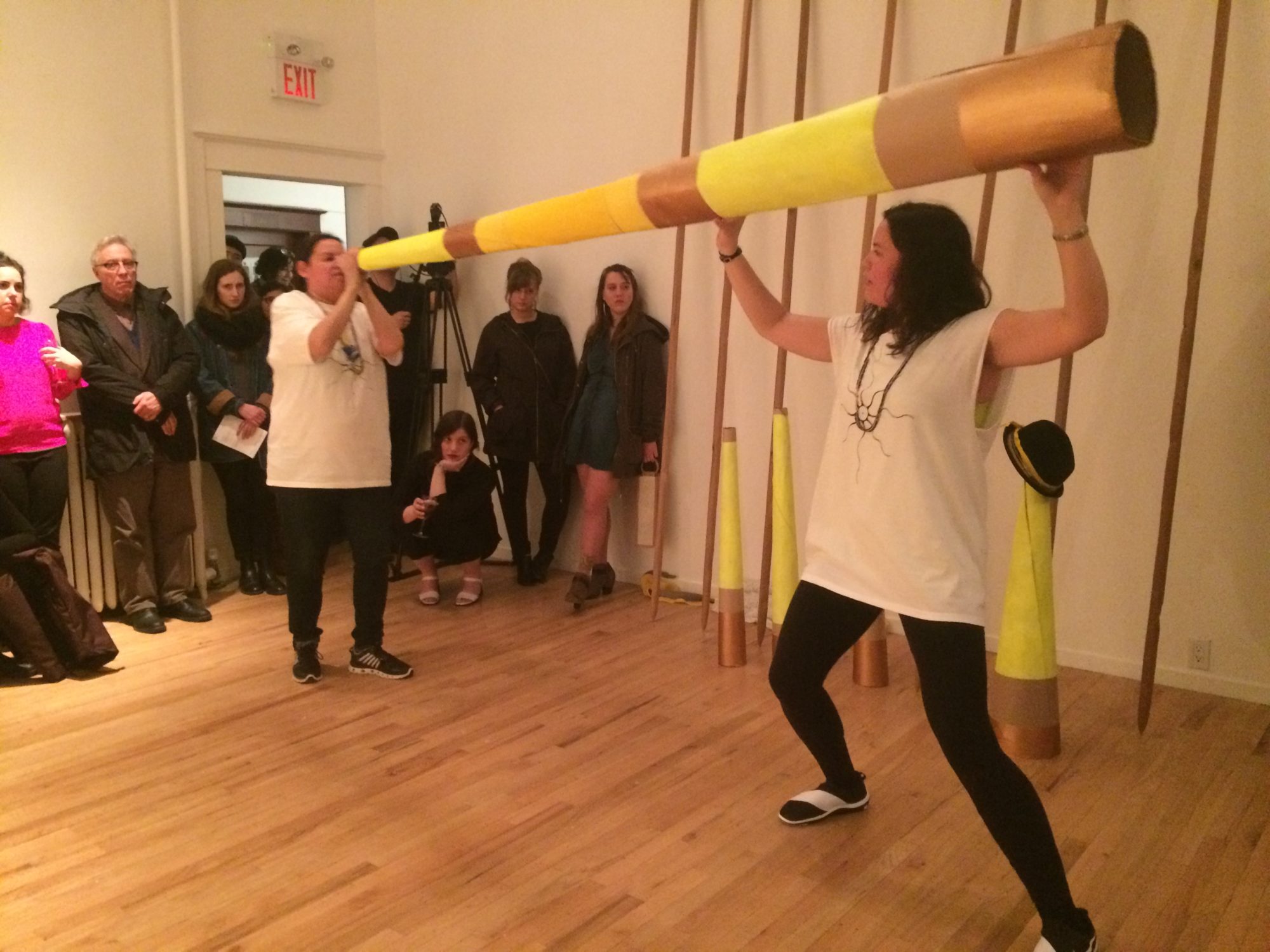Deep Focus
An inner truth
My first experience of a work by Charlene Vickers, in August 2015, was a charged encounter. It was presented in the window of Artspeak, a Vancouver artist-run space, and viewed from the street. Installed on a long custom-built wall was her father’s collection of Haudenosaunee False Face masks, punctuated by the Diviners, 2010, cedar healing spears she had made in remembrance of Vancouver’s missing Aboriginal women. Located in the part of the city called the Downtown Eastside and facing Carroll Street, her installation spoke directly to the dislocated and disenfranchised indigenous people who fall into the cycles of violence that permeate the neighborhood. Missing women are all too common in this community, in our shared history.
Last Night What I Saw
by Charlene Vickers
Those Kookums can really swing and sway1
Banging their heads up and down
Surreal rhythms
With heavy metal guitars
Making new worlds spin
Punctuating and punching out
New realms and realities
Arms that once carried water
Now pump air
In and about this mouldy old town
They live way up high
In a shiny condo tower now
Pulling a no-show
Vacant of hip hop beatz
Amplified histories of
Hearts, minds and spirits
Black metal echoes now
Deep at midnight
My sights are in awe
They care for no one now
Partying late in indulgence
Late into crazed twilight zone affinity
Kookums rock
My Kookums make heavens
Sing
Sway
and pray
White men’s lords must listen
that’s what they say
Many Vancouver artists—such as Althea Thauberger and Rebecca Belmore—have been drawn to this epicenter of violence and disappearance and have worked with this site, unraveling its layers of social inequality. Vickers’s project was thoughtfully curated by Kim Nguyen, who took care to explain the original ceremonial role of the masks and the artist’s intention of animating them with the presence of the hand-carved spears.

Rebecca Belmore. The Named and the Unnamed, 2002. Video installation. Collection of the Morris and Helen Belkin Gallery, UBC, Vancouver.
I later learned that Vickers had been adopted as a child, by a non-Native Canadian family, and grew up with her father’s mask collection hanging on the walls of the family’s rec room. She only became fully aware of the social disparity of Aboriginal people when she moved to Vancouver, went to art school, and got a job in a Native art gallery located in Gastown (the same neighborhood as Artspeak), where the main street is thick with tourists, and addicts are driven to the alleys and single-room-occupancy hotels. Working as a gallery clerk, Vickers often overheard abusive stereotypes of Aboriginal people spoken by the sightseeing and souvenir-shopping customers.
She responded to this experience by looking at her cultural heritage. She began producing works that integrated native forms with colonialist offenses and their subsequent generalizations, starting with a series of moccasins made from cardboard beer cartons. Vickers researched traditional techniques and adorned these paper slippers with decorative stitching, quillwork, and a mixture of handmade and purchased beads. The store-bought beads have letters that spell English or Anishnabe Ojibwa words. For the artist, both languages evoke a remembering, a way of finding a sense of place in the elliptical trajectories of family and nationhood.
Charlene Vickers has continued with this internal spirit recalibration, in order to equalize her sense of place and being. Her performances refer to the land and its historic violence, and manifest her contemporary experience of inherited language and class division. She foregrounds the role of ritual, guided by a search for belonging and powered by a desire to exorcise the presumptions of nationhood, class, and our colonial history.
Where are you from? Where is Home? A location of imagined nostalgia, a dreamt memory, a space of being safe, a space to vent, a trying to comprehend, to understand, breathe, swallow a hollow, cry, believe in possibility, simmer and shake, quake, fall down drunk, sleep, wake up, feed your cats, clean up a mess, wash your body parts, cling to the past, invent a family, insult your loved ones, congratulate oneself, do repeated imitations of your neighbors, do imitations of the cat speaking, hide wrongful doings, act like you are right all the time.
In that place where we do all these actions is where we are from. Our culture of ordinariness. My home territory, a rented room(s) to share with a partner of function/disfunction. There is no art or performance of self, identity—just repetitions of keeping a balance between two people and staying buoyant.
This is home territory of a woman and a man who keep a balance of turbulence and boredom over two decades and counting. When asked where I am from: A location on a map does not mean a thing in terms describing my cultural background. My Indianness seems to simmer deep inside my guts, boiling over and tipping the balance in my home on a regular basis. The outside world keeps pushing me around in overt and covert ways. I get tired of confronting it and yelling at it. The woman eclipses and overshadows the man in this territory—in our culture of homelife. It might seem sad, but there is happiness in memory of the good days and the great laughs in this place and space we share. Balance achieved when we speak of those moments together and smile quietly as two.
—Charlene Vickers
In May 2017, almost two years after Vickers’s Artspeak exhibition, the gallery received an email accusing Vickers of cultural appropriation and spiritual theft, and the writer insisted that the gallery take down images of the False Face masks from its website. These statements are in line with perspectives issued by the traditionalist society of Haudenosaunee, or Iroquois, about these ceremonial masks, which embody the healing spirit of Ethiso:da’ (our grandfather). In 1995, the sitting Onondaga Nation chief, the Tadodaho, published a statement prohibiting the sale, exhibition, or reproduction of these sacred objects. After Artspeak received the email, Vickers and I spoke about her intention in using the masks; she hadn’t planned to include them in the show until her father passed and she inherited them:
“My dad passed in 2014, and my brother sent me the masks in May 2015. We were going to only show the spears in the window, but I felt that the circumstances all pointed toward having the spears and the masks together. I knew and was aware of the protocols of the masks but felt that the urgency of the social history and realities of missing Native women and violence outweighs the rules of keeping the masks from being seen. I realize that these protocols are in place to protect the life and purpose of these masks. But sometimes there are moments when you have to make life decisions, and I made these choices on my own accord, using the tools I have at hand.”
Vickers expressed sadness for any anger she may have caused and wonders if there will ever be a right time for a gesture like hers. The show was named Asemaa/Tobacco, for the substance that is ceremonially burnt alongside the masks as an offering, and the artist considered the exhibition as such an offering. Traditional Haudenosaunee call for the return of their masks and insist on no distribution of information on their medicine societies or their purpose. Vickers inherited these medicine masks from her non-Native father but inherited her role in their use by listening to her inner truth. They were present while she grew up, and she feels like they are family. Since presenting this project, she has committed to never again show them in public. Instead, she recently brought another mask to be a witness for a performance at the Western Front gallery in Vancouver, as a response to her friend Maria Hupfield’s exhibition in which Hupfield “explore(d)…archives of cultural knowledge and the management of that knowledge by an outsider (her non-Native, Canadian father) to consider possible models for settler and immigrant accomplices in conversation with indigenous peoples as well as indigenous to indigenous relations.”2 In the performance, Vickers uses a simple, plaintive tone to speak of connectivity and commonality.
Video documentation, Performance in conjunction with Maria Hepfields’s solo exhibition at Western Front, Vancouver BC, John Hupfield’s Woodland Indian Art and West Coast Indian Art, April 20, 2017. Courtesy of the artist and Western Front.
“For the performance at the Western Front, I purposely brought in another mask that was not one of the False Face masks. I was trying to make visible a caring for an object that had a life and energy like another person, only more vulnerable. I need to keep [the masks] safe, and they are extensions of my family. At this moment I am their protector and keeper, and I take great care in carrying out this task.”
Vickers respects the grievances of the Haudenosaunee people and has made every effort to take down all known web images of the masks. Though she was raised with the presence of these objects, if not their purpose, and only now is rediscovering her cultural traditions alongside so many others in the indigenous diaspora, Vickers continues to listen to moments, situations, and her inner voice. While she is interested in the cultural objects and technologies of the past, her concerns are motivated by the world around her, her most recent performance works have been dedicated to the land and water protectors who are fighting across the nations. With deep respect for the dimensions of these traditional art forms, she integrates them into her hybrid contemporary project. This is her calling.
Charlene Vickers is an Anishnabe Ojibwa artist from Kenora, Ontario, currently living and working in Vancouver, British Columbia. She graduated from the Emily Carr Institute of Art and Design and received an MFA from Simon Fraser University. She is on the board of directors at grunt gallery in Vancouver. Her work, Sleeman Makazin, is in the permanent collection at the Museum of Anthropology at the University of British Columbia (UBC) in Vancouver. Her recent exhibitions include: Vancouver Art Gallery, Vancouver; Grace Gallery, Brooklyn, New York; Western Front, Vancouver; AKA Gallery, Saskatoon, Canada.
1. Kookums is the Cree term for grandmothers.
2 “John Hupfield’s Woodlands Indian Art and West Coast Indian Art,” Western Front.



